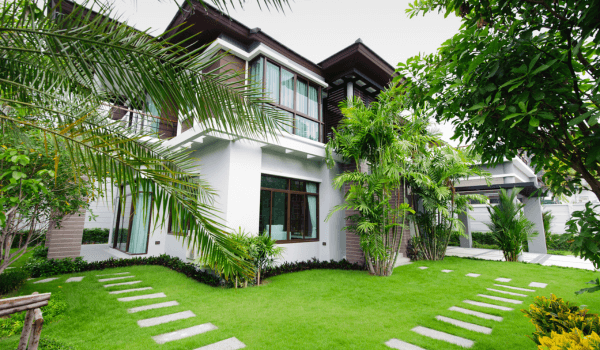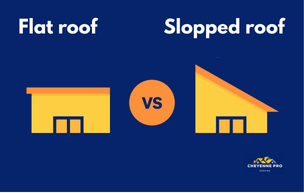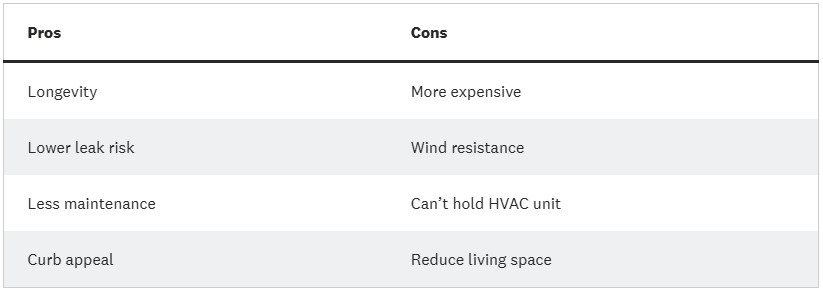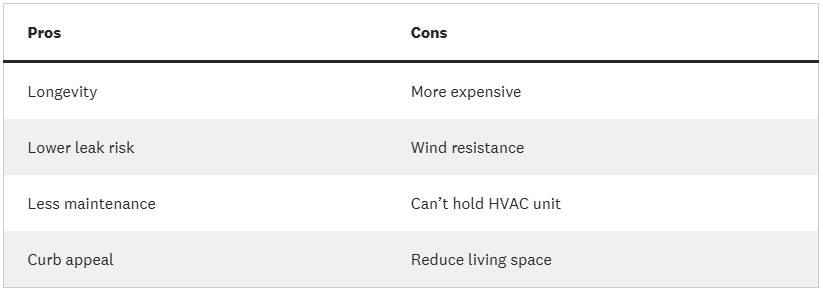
Selecting a roof design can sometimes feel like a slippery slope?or maybe it?s surprisingly straightforward.

When you?re building or upgrading a home, few things are as important as the roof over your head. Not only does it need to protect your house from the elements, but it also plays a huge role in your home?s overall look, energy efficiency, and resale value. Two of the most common styles are the flat roof and the pitched roof?and while they might seem straightforward, there?s more to them than meets the eye. So how do you know which one to choose?
If you?ve been curious about a flat roof, a pitched roof, or even commercial flat roofing options, stick around. We?ll walk you through the major differences, the pros and cons of each style, and what to consider if you ever need a flat roof replacement or a new sloped roof installation. By the end, you?ll have a clearer idea of which roof design works best for your lifestyle, climate, and budget.
The Basics: Flat Roofs vs. Pitched Roofs

What Is a Flat Roof?
A flat roof, despite the name, isn?t 100% level. It has a slight slope?often just enough to guide water toward a drain system and avoid ponding. Because there?s no obvious peak, flat roofs are typically hidden when viewed from the street. That?s part of why you see them on many commercial buildings and multi-family residences, though some modern-style single-family homes also utilize them.

Flat roofs can be made from different materials, such as asphalt, modified asphalt, or single-ply membranes (like TPO or EPDM). You might hear them referred to as ?commercial flat roofing? systems because they?re so common in commercial construction. One major bonus? Because they?re nearly horizontal, they can house HVAC units or solar panels without big, awkward angles. Plus, they often cost less upfront than a full pitched roof.
However, they do have their quirks. Since water doesn?t run off as easily, you?ve got to be diligent about drainage and maintenance. If drains get clogged or membranes get punctured, you could wind up with leaks or structural damage. With a flat roof, think ?preventive care,? because regular inspections, drain cleanings, and occasional resealing will save you plenty of stress (and cash) down the road.
What Is a Pitched Roof?
On the flip side, a pitched roof has a more traditional sloping shape you see in most single-family homes. The angle can vary?some are gently sloped, while others form a dramatic A-frame. The key is that water, snow, and debris slide off more easily, which naturally cuts down on the risk of pooling or leaks.

Pitched roofs offer a wide range of materials, from budget-friendly asphalt shingles to premium slate or copper, which can last decades (sometimes even a century or more if well-maintained). Because these roofs are front and center, they can add major curb appeal, which in turn can boost your property value. Maintenance is simpler, too; you usually just need periodic inspections to check for loose shingles, damage after storms, and general wear and tear.
That said, pitched roofs can be pricey when it comes to new installation or replacement. They also don?t handle high winds as gracefully as a flat roof, since the overhanging eaves can catch gusts and possibly sustain damage. But if you?re in an area with heavy snowfall or lots of rainfall, a pitched roof helps protect your home by letting all that water slide off naturally.
Key Differences You Should Know
1. Aesthetics and Curb Appeal
A pitched roof is visible from the street, which means it becomes a big part of your home?s ?face.? You can choose materials, colors, and shingle types that really make your house pop?think of it as a design statement. Flat roofs, on the other hand, are mostly hidden. If your home?s style is contemporary and sleek, a flat roof might fit perfectly with that clean, minimalist look. But if you?re aiming for a classic, cozy vibe, pitched may be the way to go.
2. Cost and Installation
Generally, a flat roof is less expensive to install compared to a pitched one. You?re looking at lower labor costs and fewer materials?on average, flat roofs tend to be around 20?25% cheaper. That gap widens if you?re thinking about high-end pitched materials like slate or copper, which can be triple the cost of some flat roof systems. However, keep in mind that while a flat roof starts out cheaper, you?ll probably spend more over time on maintenance and potential repairs.
3. Maintenance and Longevity
Flat roofs need more hands-on care. You?ll likely have to reseal them every few years, keep drains cleared, and watch out for standing water. Because water doesn?t roll off naturally, leaks can be a bigger headache. Flat roof membranes also don?t last as long, with an average lifespan of around 10 to 30 years.
Pitched roofs typically need less babysitting. They can last anywhere from 15 years for lower-cost shingles to well over 100 years for premium materials like slate. The slope takes care of most drainage, so there?s a lower likelihood of leaks if everything is installed properly.
4. Weather Resistance
In high-wind areas, a flat roof can be more stable because there?s no large overhang to catch the wind like a sail. But watch out for debris that can land up there and puncture the roof membrane. Meanwhile, pitched roofs are stellar at handling heavy snow or rain?gravity does the work. If you live somewhere with lots of storms, hail, and changing temperatures, the pitched approach is often the safer bet, though strong winds might still pose a risk to those extended eaves.
5. Interior Space and Energy Efficiency
One subtle advantage of a flat roof is it doesn?t cut into your upstairs living space. Pitched roofs can sometimes limit the usable square footage in upper rooms because of the sloped ceilings. On the flip side, some homeowners love the look of vaulted ceilings that pitched roofs can provide.
When it comes to energy efficiency, both designs can be optimized with proper insulation and installation techniques. Flat roofs can allow for thicker insulation layers, whereas pitched roofs often rely on attic insulation. Both can be outfitted with reflective materials or specialized coatings to minimize heat absorption.
6. Repairs and Replacements
If you end up needing a flat roof replacement, you can often do partial membrane patches instead of tearing off and reinstalling an entire section. Access is also easier (it?s flat, after all), which usually lowers labor costs for smaller repairs. For a pitched roof, you might have to replace more shingles or panels at once, especially if the damage is widespread. Then again, the extended lifespan might mean fewer total replacements over the life of your home.
Making the Choice
Still on the fence? Here are a few factors to weigh:
- Your Local Climate: Does your region see more rain and snow, or is it known for strong winds? Heavier precipitation often favors a pitched design, while windy spots might lean toward flat.
- Architecture and Style: Want a modern flair or a classic look? A pitched roof can add a traditional aesthetic, whereas a flat roof can make your home appear more contemporary.
- Budget: Flat roofs are cheaper initially, but you might pay more for maintenance. Pitched roofs cost more up front but can offer you decades of relatively low-key care.
- Long-Term Plans: If you?re staying in your home long-term, a pitched roof?s longevity might justify the higher installation costs. If it?s a short-term project or a commercial flat roofing job for a building you don?t plan to keep forever, the flat route could be more cost-effective.
Don?t forget that local building codes or HOA guidelines might also restrict which type of roof you can have. It?s always wise to consult a reputable roofing contractor who knows the local rules and can help you figure out the specifics for your property.
Pro Tips for Flat Roof Owners
If you decide on a flat roof, or you already have one, stay ahead of the game by scheduling regular inspections?especially after big storms. Keep the drains clear of leaves and debris to prevent puddling. And remember: if you spot minor damage, fix it sooner rather than later. Small punctures or tears can turn into major leaks fast, and that can lead to some very pricey water damage.
When your flat roof starts getting close to the end of its lifespan, consider planning for a flat roof replacement. Newer materials like TPO membranes are often more durable and energy-efficient than older systems, which can help you save on utility bills and reduce maintenance headaches.
Pro Tips for Pitched Roof Owners
If your home sports a pitched roof, you?ve got less day-to-day maintenance to worry about, but that doesn?t mean you can go on autopilot forever. Inspect shingles once or twice a year?ideally in spring and fall?to catch any loose or missing pieces. If you?re comfortable with heights, you can do a quick scan with binoculars from the ground to see if anything looks off.
After heavy storms, be mindful of leaks or moisture stains on your ceiling. And if you have trees close to the house, keep branches trimmed to reduce debris and prevent damage. If you ever need partial replacements, try to match the new shingles as closely as possible to the existing ones for a cohesive look.
Choosing between a flat roof and a pitched roof is all about striking the perfect balance for your lifestyle, budget, and local conditions. A flat roof might save you money upfront and give you handy space for HVAC units or solar panels. Meanwhile, a pitched roof can shed rain and snow more effectively, last longer, and potentially increase your home?s value.
Before you jump into any major roofing decision, do your research, talk to local contractors, and consider the long-term upkeep that each style requires. The right choice is the one that fits your home?s style, meets your climate challenges, and doesn?t keep you up at night every time the forecast calls for rain. After all, the best roof is the one you can live under with complete peace of mind.
--
FAQs about Flat Roofs and Pitched Roofs
Which roof style lasts longer overall?
Generally, a pitched roof has the potential for a much longer lifespan?anywhere from 15 years to over a century, depending on the material. Flat roofs usually tap out between 10 and 30 years. However, regular maintenance can help either style reach its maximum potential.
Is a flat roof more prone to leaking?
Yes, flat roofs are more likely to develop leaks, largely because water doesn?t run off as easily. They rely on drains or a very slight pitch to move water away. Regular drain cleaning and membrane inspections can minimize the risk.
Are flat roofs only for commercial buildings?
Not at all. While commercial flat roofing is extremely common, plenty of modern and minimalist residential designs use flat roofs as well. It really depends on your aesthetic and what works best for your property?s layout.
Which is cheaper: a flat roof or a pitched roof?
A flat roof is generally less expensive upfront. You?ll likely see lower installation costs and simpler materials. A pitched roof can cost more initially?especially if you opt for premium shingles or metal?but it often requires less frequent maintenance and can boost curb appeal and resale value in the long run.
Can I install a flat roof or pitched roof myself?
Roofing is tricky work, and DIY roofing can be risky. Pitched roofs require skill to handle the slope safely, and flat roofs need specialized equipment to seal membranes properly. It?s usually best to hire a pro, especially if you?re dealing with larger projects or have limited roofing experience.